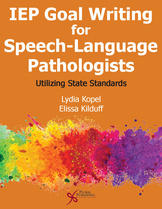Publication

IEP Goal Writing for Speech-Language Pathologists
Utilizing State Standards
- Details:
- 194 pages, Illustrated (B/W), Softcover Layflat, 8.5 x 11"
- ISBN13:
- 978-1-59756-941-5
- Release Date:
- 04/18/2016
Overview
IEP Goal Writing for Speech-Language Pathologists: Utilizing State Standards familiarizes the speech-language pathologist (SLP) with specific Early Learning Standards (ELS) and Common Core State Standards (CCSS) as well as the speech-language skills necessary for students to be successful with the school curriculum. It also describes how to write defensible Individualized Education Plan (IEP) goals that are related to the ELS and CCSS.
SLPs work through a set of steps to determine a student's speech-language needs. First, an SLP needs to determine what speech-language skills are necessary for mastery of specific standards. Then, the SLP determines what prerequisite skills are involved for each targeted speech-language skill. Finally, there is a determination of which steps to mastery need to be followed. It is through this process that an SLP and team of professionals can appropriately develop interventions and an effective IEP.
The text takes an in-depth look at the following speech-language areas: vocabulary, questions, summarize, compare and contrast, main idea and details, critical thinking, pragmatics, syntax and morphology, and articulation and phonological processes. These areas were selected because they are the most commonly addressed skills of intervention for students aged three to twenty-one with all levels of functioning. For each listed area, the text analyzes the prerequisite skills and the corresponding steps to mastery. It provides a unique, step-by-step process for transforming the steps to mastery into defensible IEP goals.
The key is to remember that the goal must be understandable, doable, measurable, and achievable. This text provides clear guidelines of quantifiable building blocks to achieve specific goals defined by the student's IEP. School-based SLPs are instrumental in helping students develop speech and language skills essential for mastery of the curriculum and standards. All SLPs working with school-aged children in public schools, private practice, or outpatient clinics will benefit from the information in this text.
Preface
Chapter 1. Early Learning Standards
3 Year Olds
4 Year Olds
Chapter 2. Common Core State Standards (CCSS)
Kindergarten
1st Grade
2nd Grade
3rd Grade
4th Grade
5th Grade
6th Grade
7th Grade
8th Grade
9th-10th Grade
11th-12th Grade
Chapter 3. Prerequisite Skills and Steps to Mastery
Vocabulary
Questions
Summarize
Main Idea and Details
Critical Thinking
Pragmatics
Syntax and Morphology
Articulation and Phonological Processes
Chapter 4. Writing IEP Goals
What to Include in a Goal
Criteria for Mastery
Measuring Progress
Goal Examples
Appendix 4-1. Goal Writing Worksheet
References
Index
About The Authors
Lydia Kopel, EdS, CCC-SLP, currently works in a large metro school system as a lead speech-language pathologist. Her primary responsibilities include supervising clinical fellows and working on special projects. In addition, she works as a private consultant and presents all over the United States. Ms. Kopel has more than thirty-five years of experience, which includes working as an SLP in the school system and as a special education coordinator. During that time she developed several resource manuals for SLPs and teachers of the hearing impaired and visually impaired.
Elissa Kilduff, MA, CCC-SLP, works as the lead speech-language pathologist (SLP) in a large metro-Atlanta, Georgia school district. Ms. Kilduff supervises, supports, and trains more than 175 school-based SLPs. Elissa has a great interest in language-based learning disabilities, collaboration in general education classrooms, and service delivery models for adolescents. Prior to her lead role, Ms. Kilduff worked as an SLP in multiple elementary schools.
Related Titles
Here's How to Treat Childhood Apraxia of Speech
446 pages, Illustrated (B/W), Softcover, 8.5 x 11"
Common Core State Standards and the Speech-Language Pathologist
Edited by: Lissa A. Power-deFur
249 pages, Illustrated (B/W), Softcover, 7 x 10"
Neurolinguistic Approach to Reading
320 pages, Illustrated (B/W), Softcover, 8.5 x 11"
Educating Students with Autism Spectrum Disorder
Joshua K. Harrower, Louis G. Denti, Marcia Weber-Olsen
245 pages, Illustrated (B/W), Softcover, 7 x 10"
The FILTER Approach
383 pages, Color Illustrations (4 Color), Spiral Bound, 8.5 x 11"
A Guide to School Services in Speech-Language Pathology
312 pages, Illustrated (B/W), Softcover, 8.5 x 11"
The Late Eight
467 pages, Illustrated (B/W), Softcover, 7 x 10"
Educating Latino Preschool Children
232 pages, Illustrated (B/W), Softcover, 6 x 9"
Working with Families in Speech-Language Pathology
Nicole Watts Pappas, Sharynne McLeod
358 pages, Illustrated (B/W), Softcover, 6 x 9"
Emergent Literacy
Sonia Q. Cabell, Laura M. Justice, Joan Kaderavek, Khara L. Pence, Allison Breit-Smith
165 pages, Illustrated (B/W), Softcover, 8.5 x 11"
School Professionals Working with Children with Cochlear Implants
Patricia M. Chute, Mary Ellen Nevins
239 pages, Illustrated (B/W), Softcover, 6 x 9"
Here's How to Do Early Intervention for Speech and Language
288 pages, Illustrated (B/W), Softcover, 8.5 x 11"
Increasing Language Skills of Students from Low-Income Backgrounds
480 pages, Illustrated (B/W), Softcover, 6 x 9"
Educating Children with Velo-Cardio-Facial Syndrome (also Known as 22q11.2 Deletion Syndrome and DiGeorge Syndrome)
328 pages, Illustrated (B/W), Softcover, 7 x 10"
Effective SLP Interventions for Children with Cerebral Palsy
Edited by: Fran Redstone
400 pages, Illustrated (B/W), Softcover, 6 x 9"
Language Disorders in Bilingual Children and Adults
360 pages, Illustrated (B/W), Softcover, 6 x 9"
Improving the Vocabulary and Oral Language Skills of Bilingual Latino Preschoolers
Vera Gutiérrez-Clellen, Gabriela Simon-Cereijido, Maria Adelaida Restrepo
136 pages, Illustrated (B/W), Spiral Bound, 8.5 x 11"
Working with Interpreters and Translators
Edited by: Henriette W. Langdon, Terry Irvine Saenz
267 pages, Illustrated (B/W), Softcover, 7 x 10"
Sharing Books and Stories to Promote Language and Literacy
356 pages, Illustrated (B/W), Softcover, 6 x 9"
`



























